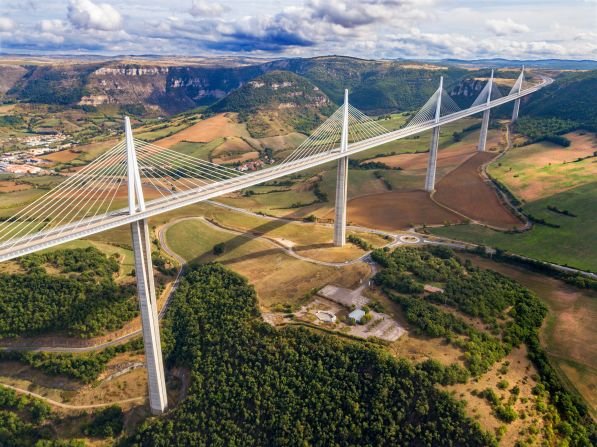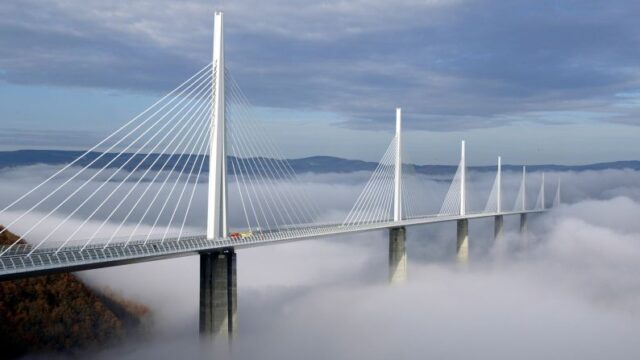How the World’s Tallest Bridge Transformed European Travel
A Landmark of Engineering and Beauty
The Millau Viaduct, soaring above the Tarn Gorge in southern France, stands as a stunning example of where engineering meets art. Often enveloped in mist, creating the sensation of driving through clouds, this bridge is so renowned that it has its own visitor center, attracting tourists who plan entire trips just to experience crossing it. Visible even from space, the Millau Viaduct is the world’s tallest bridge, with a structural height of 336.4 meters (1,104 feet) and stretching 2,460 meters (8,070 feet) in length. Despite these impressive statistics, they only begin to capture the grandeur of this architectural marvel.
A Smooth Journey Above the Tarn
Unlike many famous bridges that connect two points of similar altitude, the Millau Viaduct spans the valley with a smooth, flat course, creating a unique driving experience. The bridge’s seven piers range from 78 meters to 245 meters (256-804 feet) in height, each precisely calculated to ensure a seamless journey across the Tarn Gorge. The bridge’s design includes a span of 342 meters (1,122 feet) between each pair of piers, large enough to fit the Eiffel Tower within the gap. Seven steel pylons, each 87 meters (285 feet) tall, support the road with 11 cable stays fanning out on either side. The deck, which is around 14 feet thick and weighs 36,000 tons, remains steady, providing a secure and awe-inspiring passage for travelers.

Enhancing the Landscape
The Millau Viaduct does more than just facilitate travel; it enhances the natural beauty of the Gorges du Tarn, a protected landscape. Instead of disrupting the view, the bridge complements it, blending seamlessly with its surroundings. Described as a “wonder of the modern world” and an “engineering marvel,” the viaduct is a testament to the perfect interplay between architecture and engineering. David Knight, director of design and engineering at Cake Industries, highlights this harmonious design, noting how everyone who sees the bridge finds it spectacular.
A Strategic Solution to a Geographic Challenge
The construction of the Millau Viaduct was driven by geography. The Massif Central, a vast area of highlands with deep valleys and gorges, presented a significant obstacle for travelers moving from northern Europe to Spain. The French government recognized the need for improved infrastructure to connect the north and south of the country, leading to the decision to build a freeway that would bypass the notorious traffic bottlenecks around Millau.
Two Decades of Planning
The planning process for the viaduct took over two decades. The first challenge was determining the optimal route for the motorway. The remote location of the Massif Central made it difficult to find a suitable path. Various options were considered, including routing the freeway east or west of Millau. However, these plans either failed to connect with Millau, the only significant city between Clermont-Ferrand and Béziers, or involved significant altitude changes that complicated construction.
The Lightbulb Moment
The breakthrough came when Jacques Soubeyran, a road engineer on the project, questioned the need to route the freeway through the valley. His suggestion to span the plateau-to-plateau, rather than descending into the valley, led to the development of a cable-stayed bridge that would become the Millau Viaduct. This design allowed for a slender, aesthetically pleasing structure that would not only solve the transportation challenges but also preserve the beauty of the landscape.

The Role of Elegance in Design
The design of the Millau Viaduct was a collaborative effort between engineer Michel Virlogeux and architect Norman Foster. Foster’s vision was to create a bridge that would enhance the landscape rather than detract from it. The team’s design for a cable-stayed bridge with seven elegant piers and a slender deck has been praised for its simplicity and beauty. The choice of a cable-stayed design was driven by the need for a structure that could carry the load efficiently while remaining visually unobtrusive.
Overcoming Construction Challenges
Construction of the Millau Viaduct began in October 2001 and was completed in December 2004. The project, which cost 400 million euros, was financed by Eiffage, a private construction company that still holds the concession for the bridge. The construction process was fraught with challenges, including managing the wind forces at such a high altitude and ensuring the bridge’s stability during the assembly of the deck. The bridge’s deck was assembled from both sides and met in the middle with millimeter precision, a testament to the engineering prowess of the team.
Bridging Local Communities
Initially, there was local opposition to the viaduct, with concerns that it would spoil the natural beauty of the area and divert tourists away from Millau. However, the bridge has had the opposite effect. It has brought more tourists to the area, who come not only to see the viaduct but also to explore the surrounding landscape. The viaduct has become a destination in its own right, helping to revitalize the local economy and putting Millau on the map as a must-visit location.
A Lasting Legacy
As the Millau Viaduct approaches its 20th anniversary, it continues to be a symbol of innovation and excellence in engineering. The bridge has significantly reduced traffic congestion in the region, saving thousands of tons of CO2 emissions each year. The viaduct’s success has cemented its place as one of the world’s most extraordinary bridges, admired for both its functionality and its beauty.
Conclusion: A Modern Marvel
The Millau Viaduct is not just a bridge; it’s a modern marvel that has transformed European travel and enhanced the natural beauty of southern France. Its innovative design and engineering have made it a landmark that draws visitors from around the world, while its practical benefits have improved the lives of those who live and travel in the region. As it stands today, the viaduct continues to inspire awe and admiration, a true wonder of the modern world.











